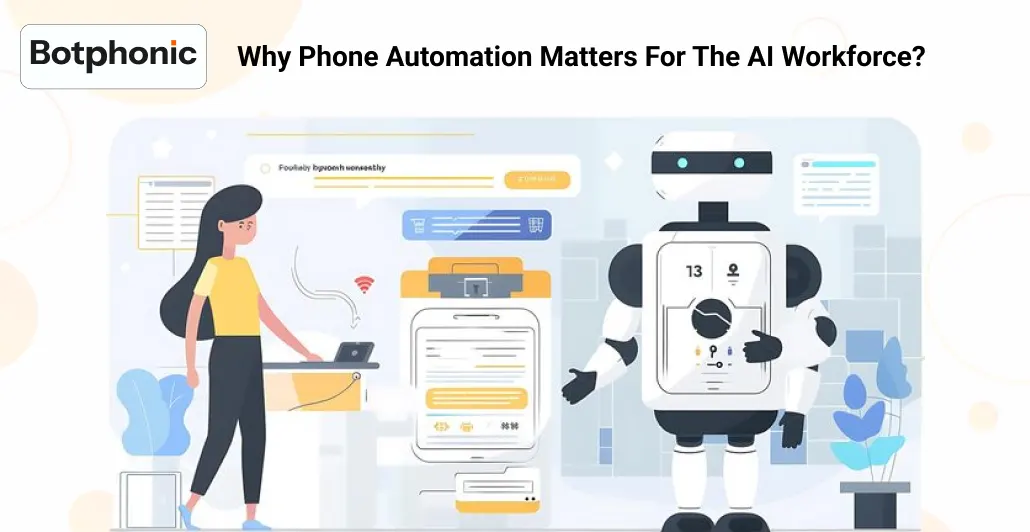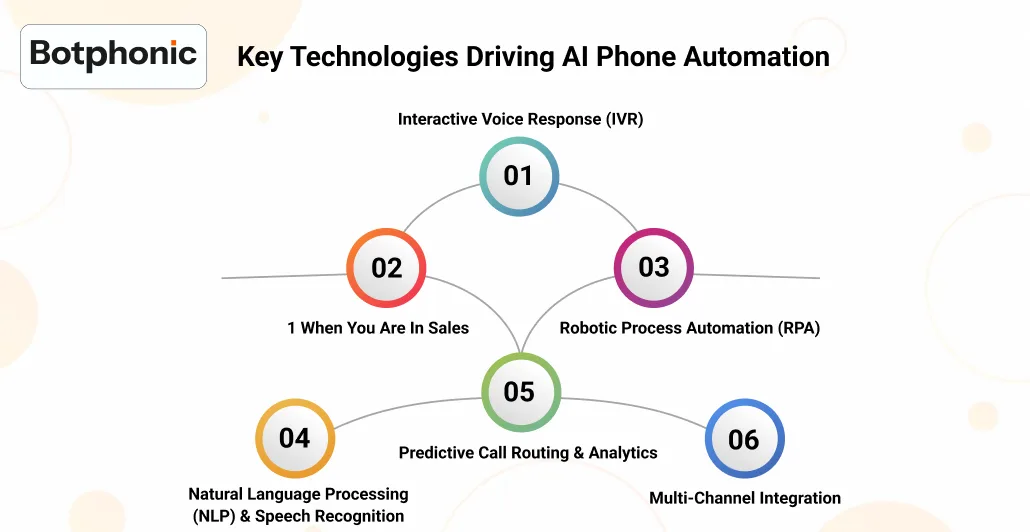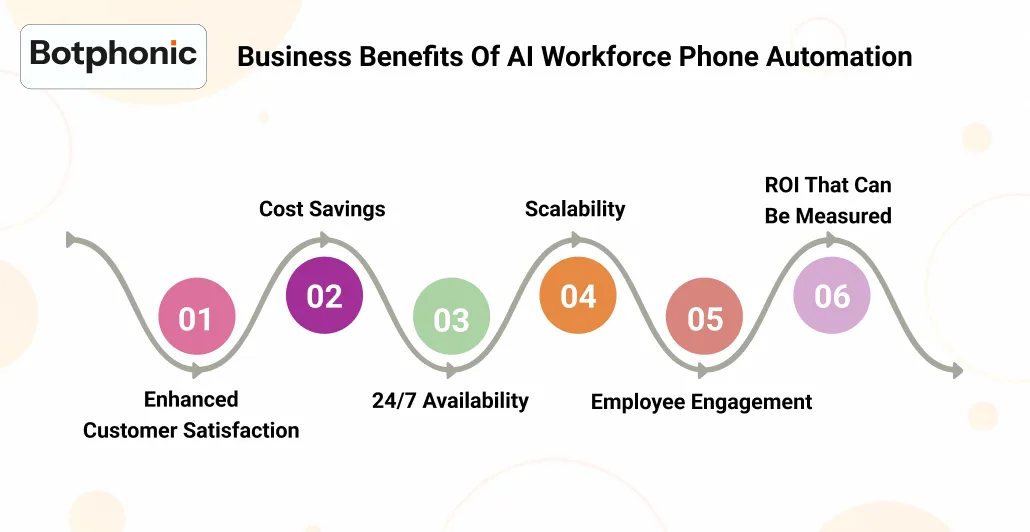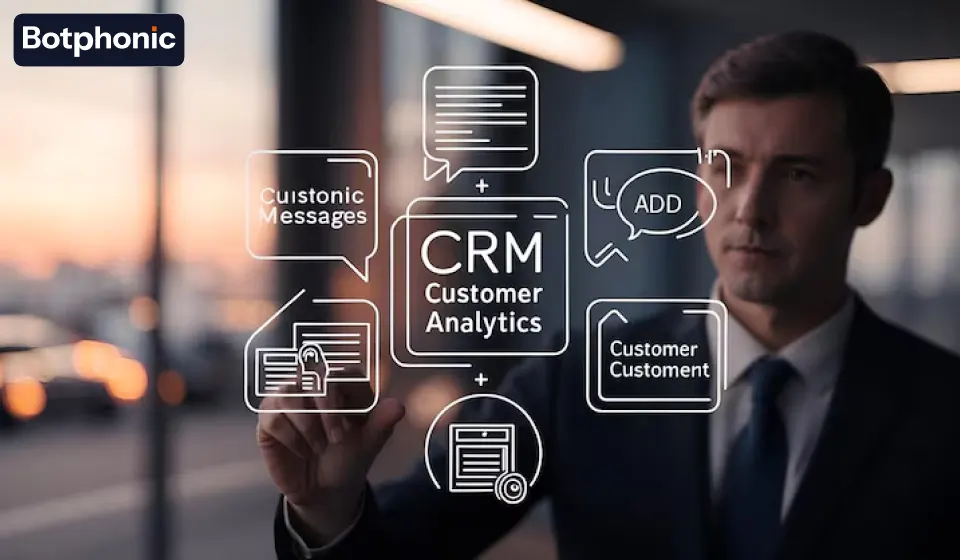
Summarize Content With:
Summary
In this blog, we will explore how post-conversation AI workforce phone automation is reshaping business communication, its technology, benefits, uses, and applications.
Key Takeaways
- AI workers in the phone automation system are driving efficiency, scalability and end customer experience across industries.
- The newest development in communication technology is NLP, predictive analytics and voice bots.
- Phone automation assists companies in deriving measurable ROI, cost savings, and more efficient service delivery.
- Implementation consists of in-depth planning, an integration approach, and the challenge on the combination of automation and the human factor.
Introduction
Imagine a company where customer calls are answered instantly, no time is wasted manually routing inquiries across departments, and handling high volumes of traffic becomes effortless.
In 2025, this is no longer a distant dream; it’s the reality made possible by AI-powered phone automation for the workforce.
Automation in phones means the application of intelligent technology, such as natural language processors, voice bots, predictive call routing, and more, to tasks typically performed by humans. The systems automate call handling, cut down response time, and improve the experience of both the customers and employees.
Automation has become a strategy amongst decision-makers and businesses as they seek to be cost-effective and agile. In this blog, you will learn everything you need to know about AI workforce phone automation, its technologies, why to automate workforce phones, how to automate workforce phones, and some of its use cases in the industry.
Why Phone Automation Matters for the AI Workforce?

Automation of the workforce is no longer a special investment; it is a worldwide movement. At the heart of this move is the application of AI in more intelligent workflows in a variety of industries, including finance, healthcare, retail, and notably communication systems.
By 2025, 80 per cent of customer service organisations will employ generative AI in one way or another, according to Gartner.
AI Phone Automation solved for pain points:
- Legacy telephone systems are inflexible, costly and not integrated.
- Handling calls manually results in longer wait times and aggravation for customers.
- When there are seasonal surges or spikes, scalability issues arise.
- Agents are also used to answer more repeated questions than valuable dialogue.
Key Technologies Driving AI Phone Automation

AI phone automation has its roots in a combination of technologies that allow systems to see, hear, understand, reason, and take action as humans do, not just at scale, but at a deep scale.
- Interactive Voice Response (IVR): Smart IVRs are not just about the famous expression, Press 1
- When you are in Sales: They apply AI in comprehending verbal requests and offering a dynamic answer.
- Robotic Process Automation (RPA): RPA eliminates human involvement in backend processes (e.g. updating CRM after calls).
- Natural Language Processing (NLP) & Speech Recognition: Enables smooth, intent-driven conversations with an AI call assistant.
- Predictive Call Routing & Analytics: Calls are increasingly routed to the most suitable agent, or AI bot, based on query type, history and sentiment.
- Multi-Channel Integration: Easily integrates with email, SMS, chat and even video to produce integrated experiences.
Companies that don’t modernise their AI call centres risk falling behind competitors offering faster, smarter, and more customer-centric service.
Core Features and Capabilities of AI-Powered Phone Systems
Phone systems powered by AI comprise sophisticated features that put a shift in communication:
- Intelligent Call Forwarding & Queues: A customer is forwarded to an appropriate resource immediately.
- Voice Bots and AI Chatbots: Manage frequently asked questions, order servicing and appointment bookings without involving humans.
- Real-Time Transcription & Sentiment Analysis: AI does not just record the calls; it helps in measuring tone and sentiment.
- Connection to CRMs & Workforce Platforms: There is automatic recording of customer interactions, hence providing context-based service.
- Analytics Dashboards: The leaders monitor such KPIs as the call resolution rate, waiting time, and customer satisfaction in real-time.
Business Benefits of AI Workforce Phone Automation

AI phone automation is not just a cost-saving instrument when applied strategically, but it changes business performance.
- Enhanced Customer Satisfaction: Speed of resolution, no hold times and tailored responses create credibility.
- Cost Savings: Costs of routine calls incurred through staffing are saved, with increased agent performance.
- 24/7 availability: AI agents do not need sleep, allowing them to serve customers globally around the clock.
- Scalability: Be able to manage high call volume without hiring.
- Employee Engagement: Agents have meaningful conversations and not monotonous work.
- ROI that can be measured: The companies can frequently estimate 20-40 per cent of reduced operational expenses in the initial year.
Key Use Cases and Industry Examples
There are industry-specific uses of AI phone automation:
- Contact Centres: Inbound call optimisation, outbound reminder and collection.
- HR & Internal Comms: Self-service by employees, payroll inquiry, and leave request.
- Financial Services: Fintech KYC identity/hypersonic verification, fraud alert, customer onboarding.
- Healthcare: scheduling appointments, accepting admissions, and reminding patients of prescriptions.
- Retail & E-commerce: Order-related status changes, processing of returns, and queries on the loyalty program.
Overcoming Challenges and Obstacles
The advantages are apparent, but hurdles can present themselves to businesses:
- Expenditure and Complexity: The initial cost may be heavy.
- Infrastructure Compatibility: All systems may be reluctant to integrate with legacy ones.
- Cultural Resistance: An employee can lose his/her job.
- Security and Governance: AI should be able to deal with sensitive data.
- Staying Human Touch: Human agents must be escalated when cases get complex.
The Future of AI Workforce Phone Automation
In 2030, AI will not only aid in the workflows of communication, but it will also be used as its leader.
- Autonomous Agents: They will have 80 per cent of routine interactions handled by AI agents.
- Hybrid Teams: Humans and AI collaborate in AI call centres.
- Personalisation 2.0: Hyper-personalisation with predictive insights.
- Job Evolution: The job will evolve, shifting from repetitive call answering to assisting with AI workflows and complex problem-solving.
Conclusion
Automation in talking to the AI workforce is no longer a choice; it is an essential competitive advantage. Smart technologies such as NLP, predictive routing, and voice bots can be integrated to cut costs, improve efficiency, and create outstanding AI customer service experiences through interaction between the businesses and their customers.
Embracing automation increases the future of organisations that do this, not only to scale their operations but also to make the workforce more empowered and customers delighted. To succeed in 2025 and beyond, it is time to explore, experiment and implement automated phone system to remain on the leading edge.

